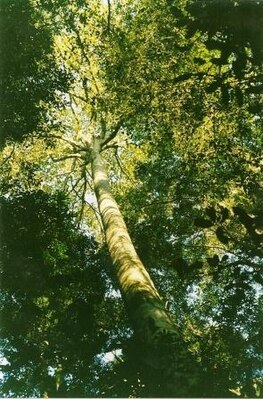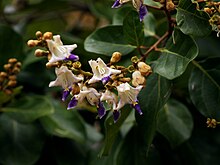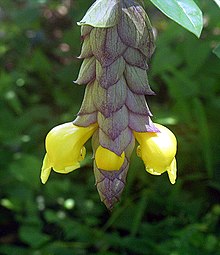Gmelina
| Gmelina | ||||||||||||
|---|---|---|---|---|---|---|---|---|---|---|---|---|

|
||||||||||||
| Systematics | ||||||||||||
|
||||||||||||
| Scientific name | ||||||||||||
| Gmelina | ||||||||||||
| L. |
Gmelina is a genus within the family of the mint (Lamiaceae). The 31 species have a purely palaeotropic distribution.
description









Appearance and leaves
Gmelina species usually grow as trees or large shrubs , rarely semi-shrubs . Young specimens often grow by climbing. Some species form buttress roots . The bark of the trunks and branches is bare or hairy with simple trichomes . The bark of the often thorny branches is woolly hairy.
The constantly against arranged on the branches leaves are divided into petiole and leaf blade. The simple leaf blades are sometimes lobed and often have glandular spots near their base. The underside of the leaves is often mealy gray.
Inflorescences and flowers
Compound, richly branched zymous or paniculate whole inflorescences of short dichasias , each of which usually contain a few flowers, stand on terminal inflorescence shafts . The bracts are foliage-like. In some species, the flowers stand individually in the leaf axils.
The hermaphrodite flowers are zygomorphic with a double flower envelope . Four or five durable sepals are fused tubular or bell-shaped and the often crooked calyx ends truncated or with four to five often unequal calyx teeth. There are mostly large glands on the sepals. The five petals are fused to form a corolla tube, which is narrow at the base and widens towards the top. The crown is more or less two-lipped, with the upper lip being two-lobed and the lower lip being three-lobed. The middle corolla lobe of the lower lip is larger than the lateral ones. The four stamens protrude at most a little beyond the corolla tube. The stamens are inserted in the lower area of the corolla tube. The dust bags open with a longitudinal slit. The four fruit leaves are a top permanent, vierkammerigen ovary grown. The thread-like stylus ends in an unequal bilobed or awl-shaped scar.
Fruits and seeds
The enlarged sepals are still present on the dry stone fruits . The endocarp is hard and the mesocarp is fleshy. The drupes contain four or, because not all ovules develop further, two or three seeds.
Systematics
The genus Gmelina was established in 1753 by Carl von Linné in Species Plantarum , 2, p. 626. The type species is Gmelina asiatica L. The generic name Gmelina honors the botanist Johann Georg Gmelin (1709–1755). Synonyms for Gmelina L. are: Gmelinia Spreng. orth. var., Cumbulu Adans. , Ephialis Sol. ex Seem.
The genus Gmelina belongs to the subfamily Viticoideae within the Lamiaceae family , earlier it was placed in the Verbenaceae family.
The genus Gmelina has a paleotropic distribution. All species naturally only occur from the Indian subcontinent via southern China and Southeast Asia to Malesia and northern Australia, as well as on some Pacific islands. For example, in tropical Africa some species are neophytes .
The genus Gmelina contains 31 species since 2012, previously up to 35 species:
- Gmelina arborea Roxb. ex Sm. (Syn .: Gmelina rheedei Hook. ): It occurs in Sri Lanka , India, Bangladesh , Pakistan , Myanmar , Thailand , Vietnam and in southern China.
- Gmelina asiatica L. (Syn .: Gmelina parviflora Roxb. , Gmelina parviflora Pers. , Gmelina attenuata H.R. Fletcher , Gmelina paniculata H.R. Fletcher ): It is widespread in Sri Lanka, India, Myanmar, Thailand, China and Vietnam.
- Gmelina australis de Kok : It wasfirst describedin 2012 from the Australian state of Northern Territory .
- Gmelina basifilum de Kok : The species first described in 2012 occurs in New Guinea and New Britain .
- Gmelina chinensis Benth. : It occurs in southern China, Laos and Vietnam.
- Gmelina dalrympleana ( F.Muell. ) HJLam : It occurs in Queensland and New Guinea.
- Gmelina delavayana Dop : It occurs only in the Chinese provinces of Sichuan and Yunnan .
- Gmelina elliptica Sm .: It occurs in India, Burma, southern China, Vietnam, Thailand, Malaysia, Singapore , Indonesia and the Philippines .
- Gmelina evoluta (Danish) Mabb. : It occurs in New Caledonia .
- Gmelina fasciculiflora Benth. : It occurs in Queensland.
- Gmelina hollrungii de Kok (Syn .: Gmelina macrophylla Schumann ): It occurs on the Moluccas , New Guinea, Australia and the Solomon Islands .
- Gmelina lecomtei Dop : It occurs in Laos, Vietnam and in the Chinese provinces of Yunnan, Kwantung and Hainan .
- Gmelina ledermannii H.J.Lam : It occurs in New Guinea.
- Gmelina leichhardtii (F.Muell.) Benth. : It is common in eastern Australia.
- Gmelina lepidota Scheff. (Syn .: Gmelina misoolensis Moldenke , Gmelina lepidota var. Lanceolata Moldenke ): It occurs on the Moluccas, New Guinea and New Britain.
- Gmelina lignum-vitreum Guillaumin : This threatened species is endemic to New Caledonia.
- Gmelina magnifica Mabb. : It occurs in New Caledonia.
- Gmelina moluccana (Blume) Backer ex K.Heyne (Syn .: Gmelina macrophylla . Wall ex Schauer , Gmelina glandulosa Hallier f. , Gmelina sessilis var. Ramiflora Moldenke ): It comes in the Moluccas, New Guinea and the Solomon Islands before .
- Gmelina neocaledonica S.Moore : It occurs in New Caledonia.
-
Gmelina palawensis H.J.Lam : There are two subspecies:
- Gmelina palawensis subsp. celebica (Moldenke) de Kok : It is endemic to Sulawesi .
- Gmelina palawensis H.J. Lam subsp. palawensis : It is endemic to the Palau Islands .
- Gmelina papuana Bakh. (Syn .: Gmelina brassii Moldenke ): It occurs in New Guinea.
- Gmelina parnellii M.H. Rashid : It was first described from Thailand in 2014.
- Gmelina peltata de Kok : It occurs only on the Solomon Islands.
- Gmelina philippinensis Cham. (Syn .: Gmelina asiatica Blanco nom. Illegit. Non Gmelina asiatica L. , Gmelina inermis Blanco , Gmelina hystrix Schult. Ex Kurz , Gmelina bracteata Burck , Gmelina szechwanensis K.Yao , Gmelina thothathriana A.Rajendran & P.Daniel ): You occurs in the Philippines, Cambodia, Vietnam, Thailand and the Chinese province of Sichuan.
- Gmelina racemosa (Lour.) Merr. (Syn .: Gmelina hainanensis Oliv. Nom. Invalid., Gmelina annamensis Do ): It occurs on the Hainan Islands, in southern China and in Laos, Thailand and Vietnam.
- Gmelina salomonensis Bakh. : It is endemic to the Solomon Islands.
- Gmelina schlechteri H.J.Lam : It occurs in New Guinea.
- Gmelina sessilis C.T.White & WDFrancis : It occurs in New Guinea and New Britain.
- Gmelina smithii Moldenke : It occurs in New Guinea.
- Gmelina tholicola Mabb. : It occurs only in New Caledonia.
- Gmelina uniflora Stapf : It only occurs in Borneo.
- Gmelina vitiensis ( Seem. ) ACSm. : It isendemicto Fiji .
Since 2012 no longer belong to the genus Gmelina :
- Gmelina indica Burm. f. → Flacourtia indica (Burm. F.) Merr.
- Gmelina siamica Moldenke → Wightia speciosissima (D.Don) Merr.
- Gmelina speciosissima D.Don = Gmelina tacabushia Buch.-Ham. ex D.Don → Wightia speciosissima (D.Don) Merr.
use
Some species ( Gmelina asiatica , Gmelina elliptica , Gmelina philippinensis ) are used as ornamental plants . The wood of some species ( Gmelina arborea ) is used. Gmelina arborea is used for reforestation. The medicinal effects of some species have been studied.
swell
- Shou-liang Chen, Michael G. Gilbert: Verbenaceae. : Gmelina , p. 22 - same text online as the printed work , In: Wu Zheng-yi, Peter H. Raven (Ed.): Flora of China , Volume 17 - Verbenaceae through Solanaceae , Science Press and Missouri Botanical Garden Press, Beijing and St. Louis, 1994, ISBN 0-915279-24-X . (Sections Description, Distribution and Systematics)
- Rogier de Kok: A revision of the genus Gmelina (Lamiaceae). In: Kew Bulletin , Volume 67, Issue 3, 2012, pp. 293–329. ISSN 0075-5974 , ISSN 1874-933X : doi : 10.1007 / s12225-012-9382-4 (sections description, distribution and systematics)
Individual evidence
- ↑ a b c d e f Rogier de Kok: A revision of the genus Gmelina (Lamiaceae). In: Kew Bulletin , Volume 67, Issue 3, 2012, pp. 293–329. ISSN 0075-5974 , ISSN 1874-933X : doi : 10.1007 / s12225-012-9382-4 .
- ↑ a b c d e Barry J. Conn, 2001: Gmelina - New South Wales Flora Online - PlantNET - The Plant Information Network System. 2.0. Sydney, Australia: The Royal Botanic Gardens and Domain Trust. Last visited on January 28, 2014
- ↑ a b c d e f Shou-liang Chen, Michael G. Gilbert: Verbenaceae. : Gmelina , p. 22 - same text online as the printed work , In: Wu Zheng-yi, Peter H. Raven (Ed.): Flora of China , Volume 17 - Verbenaceae through Solanaceae , Science Press and Missouri Botanical Garden Press, Beijing and St. Louis, 1994, ISBN 0-915279-24-X .
- ↑ First publication scanned at biodiversitylibrary.org .
- ^ Gmelina at Tropicos.org. Missouri Botanical Garden, St. Louis, accessed January 28, 2014.
- ^ A b Gmelina in the Germplasm Resources Information Network (GRIN), USDA , ARS , National Genetic Resources Program. National Germplasm Resources Laboratory, Beltsville, Maryland. Retrieved January 28, 2014.
- ↑ Lotte Burkhardt: Directory of eponymous plant names . Extended Edition. Botanic Garden and Botanical Museum Berlin, Free University Berlin Berlin 2018. [1]
- ↑ a b c d e f g h i j k l m n o p q r s t u v w x y z aa ab ac ad ae af ag ah ai Rafaël Govaerts (Ed.): Gmelina. In: World Checklist of Selected Plant Families (WCSP) - The Board of Trustees of the Royal Botanic Gardens, Kew . Retrieved January 5, 2019.
- ↑ PD Cantino et al .: Genera of Labiatae: status and classification. In: RM Harley, T. Reynolds (Eds.): Advances in labiate science , 1992, pp. 511-522.